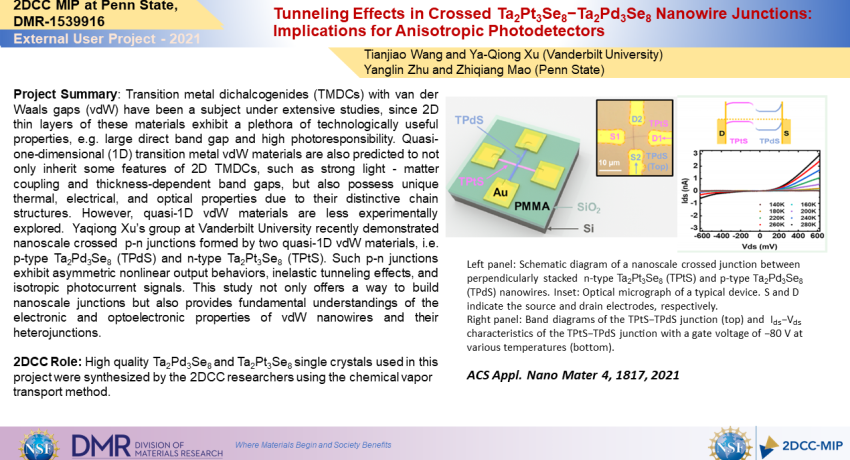Project Summary: Transition metal dichalcogenides (TMDCs) with van der Waals gaps (vdW) have been a subject under extensive studies, since 2D thin layers of these materials exhibit a plethora of technologically useful properties, e.g. large direct band gap and high photoresponsibility. Quasi-one-dimensional (1D) transition metal vdW materials are also predicted to not only inherit some features of 2D TMDCs, such as strong light - matter coupling and thickness-dependent band gaps, but also possess unique thermal, electrical, and optical properties due to their distinctive chain structures. However, quasi-1D vdW materials are less experimentally explored. Yaqiong Xu’s group at Vanderbilt University recently demonstrated nanoscale crossed p-n junctions formed by two quasi-1D vdW materials, i.e. p-type Ta2Pd3Se8 (TPdS) and n-type Ta2Pt3Se8 (TPtS). Such p-n junctions exhibit asymmetric nonlinear output behaviors, inelastic tunneling effects, and isotropic photocurrent signals. This study not only offers a way to build nanoscale junctions but also provides fundamental understandings of the electronic and optoelectronic properties of vdW nanowires and their heterojunctions.
2DCC Role: High quality Ta2Pd3Se8 and Ta2Pt3Se8 single crystals used in this project were synthesized by the 2DCC researchers using the chemical vapor transport method.
What Has Been Achieved: This work successfully fabricated nano-scale crossed junctions
composed of two vdW nanowires: p-type Ta2Pt3Se8 (TPtS) and n-type Ta2Pd3Se8 (TPdS) and revealed its unique electronic and optoelectronic properties.
Importance of the Achievement: This work not only reveals a route to build a nanoscale crossed junction between two quasi-1D vdW materials, but also shed light on the electrical transport and photocurrent generation mechanisms for the nanoscale crossed junctions.
Unique Feature(s) of the MIP that Enabled this Achievement: The 2DCC has a unique capacity of growing crystals with desired quality and property. The high-quality Ta2Pd3Se8 and n-type Ta2Pt3Se8 single crystals used in this project were synthesized using the chemical vapor transport method through fine-tuning of the temperature gradient, the transport agent and vapor pressure.
Publication: Tianjiao Wang, Yanglin Zhu, Zhiqiang Mao, and Ya-Qiong Xu, Tunneling Effects in Crossed Ta2Pt3Se8–Ta2Pd3Se8 Nanowire Junctions: Implications for Anisotropic Photodetectors, ACS Appl. Nano Mater. 4, 1817 (2021) DOI: https://doi.org/10.1021/acsanm.0c03223
This work was supported by the National Science Foundation (Grants ECCS-1810088 and CBET-1805924) and Vanderbilt Discovery Grant. Financial support for sample preparation was provided by the National Science Foundation through the Penn State 2D Crystal Consortium-Materials Innovation Platform (2DCC-MIP) under NSF Cooperative Agreement DMR-1539916.
